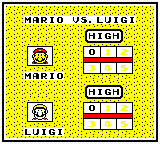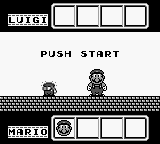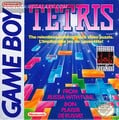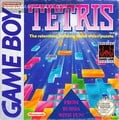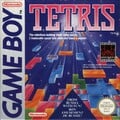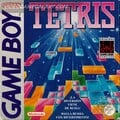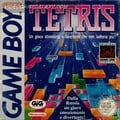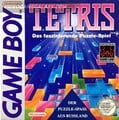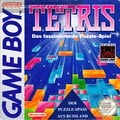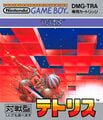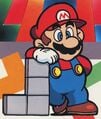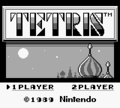Tetris
- This article is about the 1989 Game Boy game. For articles related to the Tetris franchise, see Category:Tetris series.
| Tetris | |||||||||||
|---|---|---|---|---|---|---|---|---|---|---|---|
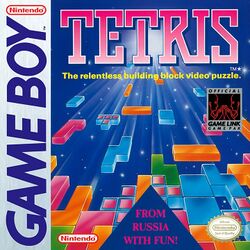
| |||||||||||
| Developer | Nintendo R&D1 | ||||||||||
| Publisher | Nintendo | ||||||||||
| Platforms | Game Boy Virtual Console (3DS) Game Boy - Nintendo Classics | ||||||||||
| Release dates | Game Boy: Virtual Console (3DS): Game Boy - Nintendo Classics: | ||||||||||
| Language | English | ||||||||||
| Genre | Puzzle | ||||||||||
| Ratings |
| ||||||||||
| Modes | Single player, multiplayer | ||||||||||
| Format | Nintendo Switch: Game Boy:
Nintendo 3DS: | ||||||||||
| Input | Nintendo Switch: Game Boy:
Nintendo 3DS:
| ||||||||||
| Serial code | DMG-TRA | ||||||||||
Tetris is a puzzle game for the Game Boy released in 1989 in Japan and North America and 1990 in Europe. It was developed and published by Nintendo (with the rights to a Game Boy version sub-licensed from Bullet-Proof Software)[4] and is directly based on Alexey Pajitnov's original rendition of Tetris. The basic gameplay involves stacking a series of blocks to create full rows with increasingly fast speeds. No elements of the Super Mario franchise appear in single-player, though two-player mode represents Mario and Luigi as the first and second players, respectively.
Tetris was made available for the Nintendo 3DS's Virtual Console in December 2011, although the title was later pulled from all regions. It was later released on the Nintendo Switch's Game Boy - Nintendo Classics service as one of its launch titles on February 8, 2023.
Gameplay[edit]
The goal of the game is to stack blocks into complete lines, removing them from play. All of the blocks, called Tetriminoes, are based on the tetrominoes (every geometric shape that can be created from four perfect squares). As play begins, a random Tetrimino falls to the bottom of the screen, and the player can position it and rotate it without being able to move it back up. After one is placed down, another appears, and this continues for every subsequent Tetrimino. In single-player, the player can choose from the A-Type or B-Type modes to play. In A-Type, the player selects the speed at which the Tetriminos fall, then the game begins. It continues forever[5] until the Tetriminos reach the top of the screen, with no more room left for them to appear. In B-Type, the goal is to clear twenty-five lines, and both the Tetriminos' falling speed and the number of misaligned blocks that are already on-screen can be selected. Once the necessary lines have been cleared, the player is scored on their performance. If they complete B-Type with the maximum settings, a special ending plays featuring the launch of a spaceship. It does not show any Super Mario characters, unlike with the Nintendo Entertainment System version.
In two-player mode, Mario and Luigi stack Tetriminos on separate fields. If one player clears more than one line, extra lines suddenly appear at the bottom of the other player's screen. Play continues until either one player runs out of space or one player clears at least thirty lines, at which point Mario and Luigi are seen celebrating or moping. The games then begin anew, with a cleared screen, until one player wins three times.
Development[edit]
Though the Game Boy had four launch titles upon its Japanese release, none of them were bundled with the console. Henk Rogers of Bullet-Proof Software convinced Minoru Arakawa to bundle the Game Boy in North America and Europe with Tetris rather than Super Mario Land, stating that the former would have broader appeal while the latter would only appeal to children. As he put it, "[i]f you want little boys to buy your machine include 'Mario,' but if you want everyone to buy your machine, include 'Tetris'".[6] Nintendo consequently encouraged Rogers to seek out the rights to develop a Game Boy port; since the game's creator, Alexey Pajitnov (Romanized on the game's startup screen as Alexey Pazhitnov), was an employee of the Academy of Sciences of the Soviet Union, this meant arranging a deal with the federal government of the Soviet Union itself.[7]
After a failed attempt at getting Robert Stein of Andromeda Software (who had previously obtained the rights for various home computer ports outside the Eastern Bloc) to work out a deal, Rogers flew out to the Russian Soviet Federative Socialist Republic to meet with Pajitnov and ELORG, the Soviet Union's state-sanctioned computer company. At the same time, Nintendo contacted Spectrum HoloByte, to whom Andromeda Software previously granted the North American distribution rights, to work on the Game Boy port, leading to a legal dispute with Mirrorsoft, who owned the European rights for home computer ports.[7] Eventually, Rogers learned that Stein had never actually contacted the Soviet government to obtain the international distribution rights, instead talking directly to Pajitnov (who Soviet law prohibited from owning the game),[8] and worked out a deal to give Nintendo exclusive home console and handheld rights for Tetris.[7] Consequently, the game's startup screen lists both Nintendo and Rogers' company, Bullet-Proof Software, as copyright holders. Rogers' efforts were later dramatized in the 2023 thriller film Tetris.
Reception[edit]
Critical reception[edit]
| Reviews | |||
|---|---|---|---|
| Release | Reviewer, Publication | Score | Comment |
| 3DS | Lucas M. Thomas, IGN | 9.0/10 | "Tetris endures. It was one of the greatest video games ever made when it first appeared back in the '80s, and it retains that status to this day. This particular version of Tetris just adds to that sense of awe, as it's inarguably the most important and nostalgic edition of the game ever published." |
| Game Boy | Marc Golding, Honest Gamers | 10/10 | "To summarize the Tetris experience is to quote Maynard James Keenan of the great rock band Tool -- as I am often wont to do: I know the pieces fit!" |
| Game Boy | Adam Riley, Cubed3 | 10/10 | "Tetris is one game that will never be forgotten, no matter how many pretenders to the thrown come and go over time. Sure, there may be some games that have actually managed to improve on the idea, but the original still stands out as one of those revolutionary games. I should not have to tell you to play this, as the majority already will have in some form or other..." |
| Game Boy | Victor Lucas, Electrical Playground | 10/10 | "Although we're talkin' moving different shapes around and fitting them into the proper positions, Tetris stands as one of the best videogames ever made. The Game Boy would be the Game Infant without it." |
| Aggregators | |||
| Compiler | Platform / Score | ||
| GameRankings | 89.73% (GB) | ||
Sales[edit]
The popularity of Tetris was immense, to the point where the success of the Game Boy is often attributed to Tetris itself.[9][10] Due in large part to the game being bundled with the Game Boy, Tetris sold over 33 million copies[11] and its combined earnings were billions of dollars.[12] The game has thus gained a reputation as the handheld's "killer app".[13] Although the game succeeded with Nintendo's core demographic of young children, the game was notably also popular with people outside of their usual audience, such as businessmen and other non-traditional gamers, and Nintendo began marketing the game towards them.[11][14]
Legacy[edit]
Tetris holds the distinction of being the first video game played in space, by Russian astronaut Aleksandr Aleksandrovich Serebrov.[15] The astronaut received the game from Nintendo's then-chairman, Howard Lincoln, while the latter was on a trip in the USSR to see Pajitnov.[16]
Gallery[edit]
Box art[edit]
Other[edit]
References in later media[edit]
- In It's a Small World After All, Tannis Rhodes mentions the game while expressing frustration at her poor Super Mario Land playing skills.
- Arrangements of "Tetris: Type A" and "Tetris: Type B" from the Game Boy Tetris can be played on Luigi's Mansion.
- The Brawl arrangement of "Tetris: Type A" reappears as a track for Smash Run.
- The Brawl arrangements of "Tetris: Type A" and "Tetris: Type B" can be played on Luigi's Mansion and Wuhu Island respectively.
- The Brawl arrangements of "Tetris: Type A" and "Tetris: Type B" can be played on Battlefield, Final Destination, and any stage that lists "Other" as their source for the game series.
Names in other languages[edit]
| Language | Name | Meaning | Notes |
|---|---|---|---|
| Japanese | テトリス[17] Tetorisu |
Tetris |
Notes[edit]
- The tagline on the Game Boy version's North American and European box art, "From Russia with Fun!", references the 1957 Ian Fleming novel From Russia, with Love, and by extent, its 1963 film adaptation.
- In a 2009 interview with IGN, Tetris creator Alexey Pajitnov stated that the Game Boy version was his favorite take on the game, as it bore the closest resemblance to his original vision.[18]
See also[edit]
- Tetris & Dr. Mario (SNES, 1994)
- Tetris Attack (SNES, 1996)
- Tetris DS (Nintendo DS, 2006)
- Tetris 99 (Nintendo Switch, 2019)
References[edit]
- ^ Nintendo. ゲームボーイ. Nintendo (official Japanese site) (Japanese). Retrieved November 27, 2024. (Archived January 28, 1997, 18:11:13 UTC via Wayback Machine.)
- ^ テトリス(TETRIS) (ゲームボーイ). Famitsu (Japanese). Retrieved November 27, 2024. (Archived October 28, 2012, 06:10:44 UTC via Wayback Machine.)
- ^ Mike Minotti (April 21, 2014). 25 years of the Game Boy: A timeline of the systems, accessories, and games. VentureBeat (English). Retrieved December 12, 2024. (Archived September 5, 2022, 10:23:05 UTC via Wayback Machine.)
- ^ "Tetris licensed to Bullet-Proof Software and Sub-licensed to Nintendo." – Boot-up screen. Tetris.
- ^ Breandan Vallance (January 22, 2023). Gameboy Tetris maxout (999999 points). YouTube. Retrieved June 21, 2024.
- ^ Levy, Karyne (June 6, 2014, 10:59 AM EDT). The Complicated History Of 'Tetris,' Which Celebrates Its 30th Anniversary Today.. Business Insider. Retrieved June 20, 2024.
- ^ a b c DeMaria, Rusel; Wilson, Johnny L. (December 18, 2003). High Score! The Illustrated History of Electronic Video Games (Second Edition). McGraw-Hill Professional (English). ISBN 0-07-223172-6.[page number needed]
- ^ Evans, David Sparks; Hagiu, Andrei; Schmalensee, Richard (August 18, 2006). Invisible Engines: How Software Platforms Drive Innovation and Transform Industries (Illustrated ed.). MIT Press. ISBN 0-262-05085-4.
- ^ Kaplan, Arie (August 1, 2013). "Games To Go." The Epic Evolution of Video Games (ShockZone ™ ― Games and Gamers). Lerner Publications Company. ISBN 978-1-4677-1585-0. Page 15.
- ^ Rollings, Andrew, and Dave Morris (2003). Game Architecture and Design. New Riders (English). ISBN 978-0735713635. Page 538.
- ^ a b Haghirian, Parissa, and Philippe Gagnon (October 13, 2011). "The Handheld Market" - Case Studies in Japanese Management. World Scientific. ISBN 978-9814340878. Page 61-62.
- ^ Sheff, David (November 2, 2011). Game Over: How Nintendo Conquered The World (eBook). Knopf Doubleday (English).
- ^ Bellomo, Mark (October 13, 2010). "Bricks and Pocket Monsters" - Totally Tubular '80s Toys. Krause (English). ISBN 978-1-4402-1282-6. Page 348.
- ^ Loguidice, Bill, and Matt Barton (February 7, 2014). "Nintendo Game Boy (1989)" - Vintage Game Consoles: An Inside Look at Apple, Atari, Commodore, Nintendo, and the Greatest Gaming Platforms of All Time. CRC Press (English). ISBN 978-0-415-85600-3.
- ^ Plunkett, Luke (May 4, 2011). "This Game Boy Has Been to Space. For Real". Kotaku. Retrieved June 21, 2024.
- ^ Nintendo Staff (1989). "A Link With The Soviet Union" - Nintendo Power. Page 54.[better source needed]
- ^ テトリス. Nintendo (official Japanese site) (Japanese). Retrieved April 26, 2025. (Archived April 26, 2025, 05:54:26 UTC via Wayback Machine.)
- ^ IGN (June 15, 2009). Tetris Turns 25, Part 1. YouTube (English). Retrieved June 1, 2024. (Archived June 1, 2024, 20:47:55 UTC via Wayback Machine.)
| Game Boy games | |
|---|---|
| Super Mario franchise | Alleyway (1989) • Baseball (1989) • Super Mario Land (1989) • Golf (1989) • Dr. Mario (1990) • Super Mario Land 2: 6 Golden Coins (1992) • Donkey Kong (1994) • Mario's Picross (1995) • Picross 2 (1996) |
| Donkey Kong franchise | Donkey Kong (1994) • Donkey Kong Land (1995) • Donkey Kong Land 2 (1996) • Donkey Kong Land III (1997) |
| Yoshi franchise | Yoshi (1991) • Yoshi's Cookie (1992) • Tetris Attack (1996) |
| Wario franchise | Wario Land: Super Mario Land 3 (1994) • Wario Blast: Featuring Bomberman! (1994) • Wario Land II (1998) |
| Miscellaneous | Tetris (1989) • The Legend of Zelda: Link's Awakening (1993) • Game & Watch Gallery (1997) • Game & Watch Gallery 2 (1997) • Game Boy Camera (1998) |
